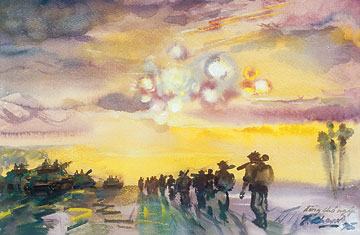
Capturing the conflict: Nguyen Thanh Chau's On the Eastern Front, 1975
During the Vietnam war, America's image of the conflict was shaped by news footage of battlefields dominated by miasmal jungle and of an enemy who was often portrayed as merciless and inhuman. But the war doesn't look that way in the drawings, poems, letters and oral histories compiled in Mekong Diaries. Author Sherry Buchanan journeyed across Vietnam to gather previously unpublished material from 10 Vietnamese artists who resisted the U.S. The resulting volume is a moving alternative to common American narratives of the war and offers extraordinary insight into Vietnamese hearts, military and civilian.
About 100 artists served in the Mekong Delta during the 11-year conflict, tasked with recording battles and creating images that could be used to inspire civilians in the war effort. Sixty-two died in action. Some were regular soldiers as well as artists; others performed no military duties but chose to go on reconnaissance missions and into combat to create their works. Recruits were trained in drawing, and professors from the Hanoi College of Fine Arts traveled the Ho Chi Minh Trail to set up art courses in the Mekong Delta before dispatching their students into battle with sketchbooks, ink bottles and paint palettes.
Many of the works — like Quach Phong's memorable watercolors — capture ordinary acts of resistance by beleaguered fighters armed with unsophisticated weaponry. Phong's Farmer with Gun (1966) portrays a leather-faced guerrilla pointing a rifle to the sky in a defiant attack on a fighter plane. "Even though he had little hope of shooting it down, there lay his strength," recalls Phong.
At other times, artists tried to depict the tense interludes between battle, documenting the interiors of their foxholes and bunkers. Some also painted furiously to preserve the landscape as it looked before the bombs and napalm. Nguyen Thanh Chau liked to capture the beauty of pink lotuses, malachite melaleuca trees and turquoise marshes under a lapis lazuli sky. "Whenever I saw a beautiful landscape, I forgot about the danger and stood up to draw," he writes.
Artists devised ingenious ways to work while under fire. Hyunh Phuong Dong perfected the technique of squeezing clumps of paint straight onto paper and adding black outlines later, once he was out of harm's way. "Their bombs cannot bury me," he wrote in a letter to his wife from the Mekong Delta. "I can still work, paint, sing and write to you." Another artist, Pham Thanh Tam, filled empty penicillin vials with paint, which he stored inside Russian-made 12-mm shell casings so that they wouldn't break.
In a war that killed more than 3.8 million Vietnamese, many military artists came to see themselves as aestheticians of common life, offering a respite from the endless bloodshed. "Because war is too hard, it is the artist's duty to create beauty," says Pham Thanh Tam. "I wanted to convey uplifting, spiritual feelings and fragile emotions." His delicate pencil sketch Carrying the Mail Down the Ho Chi Minh Trail (1968) captures an everyday tableau but poignantly so. In other pieces, iridescent young men and women in traditional dress perform the quotidian chores of transporting water and collecting wood.
Today, the Ho Chi Minh City Fine Arts Museum holds the largest collection of what is known in Vietnam as Liberation Art. The biggest buyers — perhaps unsurprisingly — are American Vietnam War veterans seeking the catharsis of art. Mekong Diaries provides just that, and testifies to the ultimate futility of armed conflict. "If we were all artists," writes another featured painter, Nguyen Thu, "there would be no war."
